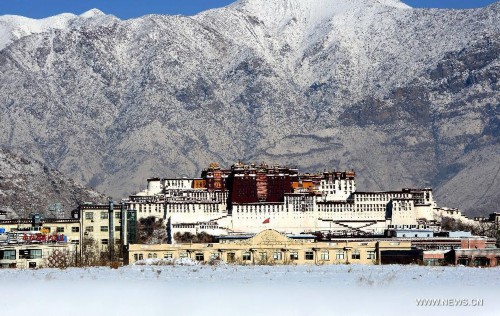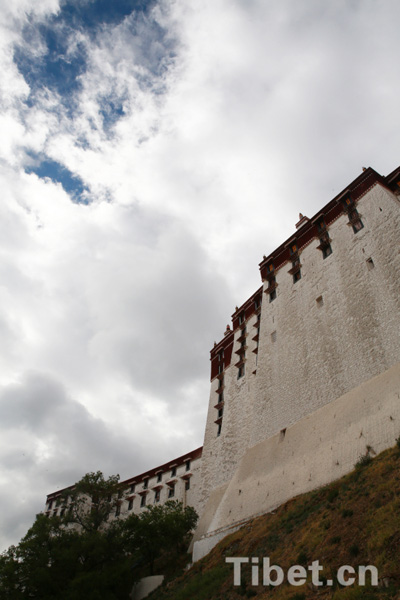Most complete guide to visit Potala Palace

The Potala Palace
The Potala Palace is considered as an icon of Tibetan architecture. Located on the Red Hill in Lhasa, it covers more than 360,000 square meters and has 13 stories. In 641, Songtsan Gambo, ruler of the Tubo Kingdom, had the Potala Palace built for Princess Wencheng of the Tang Dynasty, his bride. It enjoys supreme religous status in the heart of the Tibetan Buddhists.
1.Transportation
- Bus Routes
Taking bus No. 1, No.6, No.12, No.17, No.24 and No.25 and get off at the Lhasa Department Store Station
- Taxi
The cab fare in Lhasa is negotiable. Generally, 10 RMB is enough to get you anywhere within the citycenter.
2.Purchasing Tickets
The Potala Palace requires you to purchase your entrance tickets in advancesince the number of tickets is limited every day. Only 2,300 people are allowed to enter the Potala Palace per day (with 700 of those tickets being reserved for individual purchases). Tickets can be purchased every day after 5 pm for the following day. Every person is allowed to purchase a maximum of four tickets.
You have to wait in line the day before and present your identification document in order to purchase your tickets. Your assigned time to enter the Potala Palace will be determined by your position in line when you purchased the tickets the day before. The time to purchase tickets begins at 9 am and will end when all the tickets for the 24 hour block period are sold out.
Of course, you can also reserve your tickets online visa www.portalapalace.cn. When you buy your ticket online, the system will assign you a specific time to enter the palace grounds. You will need to enter through the second door (the sluice gate without any signboard). If you do not enter the palace grounds at your assigned time, the computer system will automatically nullify the ticket.
Tickets will be on sale beginning at 9 am and visitors will be permitted to enter the grounds at the same time.
Tickets will be checked and the doors will close at 4 pm.
All visitors will need to leave the premises by 5 pm.
3.Sightseeing overview
The Palace consists of the White and Red palaces with more than 1000 rooms. The White Palace was for secular use while the Red Palace was for religous use.
- The White Palace

The White Palace [Photo/China Tibet Online]
The first part is the White Palace. The White Palace was built in 1645, and took eight years to construct. The entirety of the building's walls are painted in white which are very striking when viewed from afar; hence winning the name "White Palace".
The White Palace has seven floors, and located on the central fourth floor of the Potala Palace, which is 717 square meters, the largest sanctuary in the palace, where the generations of the Dalai Lamas were enthroned and handled the political affairs in the history.
The 5th and 6th floors are the Regent's Office and living quarters. The highest floor (the 7th floor) is the Winter Palace of the Dalai Lama since the natural lighting in the area is very bright, and as such is colloquially known as "The Hall of the Sun".
On the outside there is a wide porch, and from this position one can overlook the entire Lhasa city.
- The Red Palace

The Red Palace [Photo/China Tibet Online]
The second part is the Red Palace, which was built in 1690.
The main building of the Red Palace houses many different kinds of Buddhist halls and stupas of the Dalai Lamas. Inside the palace are eight stupas of the previous Dalai Lamas, among which, the stupa of the fifth Dalai Lama is the biggest and the most aesthetically pleasing. Standing at 14.85 meters tall, the body of the stupa is wrapped in gold and a jade inlay. It is said that structure used 110,000 Chinese ounces of gold, as well as pearls, precious gemstones, coral, amber, agate, etc, all together numbering 18,677 pieces.
The primary function of the Red Palace is to serve as the location where religious and ceremonial functions are held, whereas the White Palace is the residence of the Dalai Lamas and also serves as a political administrative center.
The murals of the Potala Palace can divided into four different kinds: religious stories, depictions of ethnic culture, biographies, and depictions of historical events.
1.As of 2006, the golden roof located at the top of the Potala Palace is no longer open to the public. Due to renovations and other factors, the sanctuaries that are open to the public constantly change. Only a few of the most important sanctuaries remain open on a daily basis. It is recommended that you visit during the Shoton Festival, Tibetan Losar (New Year), or any other Tibetan religious holidays, so that your experience can be the most rewarding.
2.The interior of the Potala Palace has an extremely complex layout and very profound cultural value. It is recommended that you reserve enough time to fully look around the premises and wear flat and comfortable shoes when you come.
3.Finding a toilet in the Potala Palace is extremely difficult. It is recommended that you take care of your restroom needs prior to entering.
4.When you come to visit the Potala Palace, be prepared to respect Tibetan religious taboos, such as refraining from wearing a hat, taking pictures (although taking photographs from outside of a sanctuary is permitted), trampling on the doorsill, etc. All visitors must finish their tour within one hour, so loitering in any of the sanctuaries is not permitted. After the tour is completed, please exit from the west gate of the Potala Palace. Go down the slope of the hill upon exiting and you’ll be able to return to the main front gate.
5.If time is sufficient, it is recommended that you walk around the Potala Palace clockwise one time. You can witness the layfolk talking ritual walk and making their religious prostrations and experience the livelihoods of the people who live at the snowy plateau.
6.Places to photograph a panoramic shot of the entire Potala Palace: The hillside across the street is commonly known to be the best choice. The two white pagodas that we often see in many panoramic photographs are taken from this location. The landmark for this small hill is two signal towers that are managed by attendants. Summer hours are from 6:30am to 6:00 pm, and entrance fees are 2 RMB per person.
Your Comment
Name E-mailRelated News
-
;
-
-

-
New look of Potala Palace as believers become painters
Every year in autumn and winter season, Potala Palace begins its annual painting work. Staff at Potala Palace Management office and Lhasa believers spontaneously take part in the work.
-
-
-
No need to book Potala Palace tickets in advance
The Potala Palace official website booking system switched off from 24th October, stopping all online ticket sales.
-
-
-

-
Potala Palace repainted in renovation
Workers repaint the Potala Palace during an annual renovation of the magnificent ancient architectural complex in Lhasa, capital of southwest China's Tibet Autonomous Region, Oct. 21, 2015.
-
-
-

-
Potala Palace paintings preserved
Five billion pixels are the technological fix for preserving murals in Tibet's Potala Palace. The digitization project is part of ongoing efforts to safeguard temple art throughout the Tibet Autonomous Region.
-
Based in Lhasa, Tibet Vista is a Tibet travel agency that specialized in Tibet permit, and Tibet tours for both private and group travelers at a local price!
•4 Days Lhasa City Group Tour from USD 460 •8 Days Everest Base Camp Group Tour from USD 850 •15 Days Mt.Kailash Group Tour from USD 1780 •2016 Tibet Train Tours from Beijing, Shanghai, Chengdu, Xining,etc










